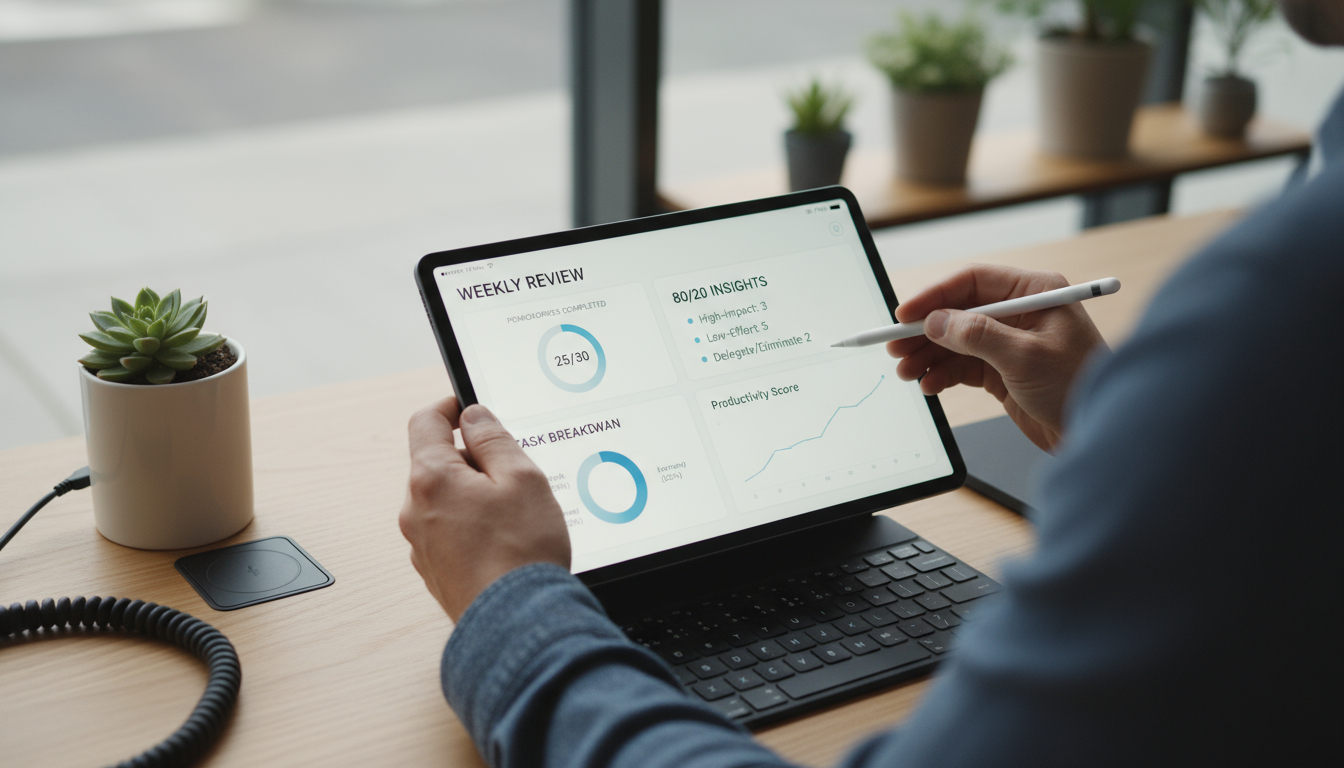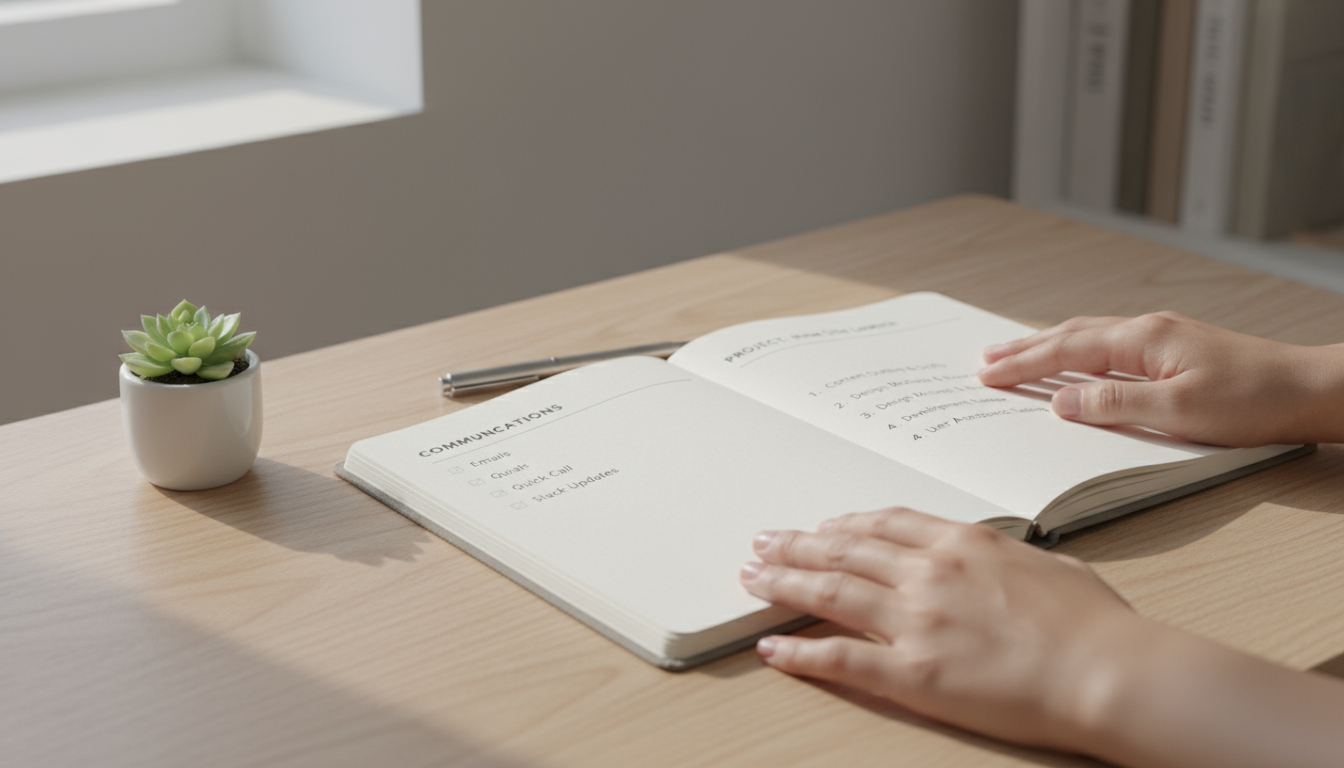
You live in a city that never sleeps, and your calendar reflects it. Your phone buzzes with notifications. Your inbox overflows. The line between work and life has blurred into a single, continuous stream of demands. You’ve tried complex scheduling systems and rigid to-do lists, but they often feel like a second job. They demand perfection in a world that is anything but predictable. You need a structure that bends without breaking, a method that works with your brain, not against it.
What if the secret to getting more done wasn’t about working longer hours, but about working smarter in short, focused bursts? What if you could reclaim your focus, reduce mental fatigue, and make steady progress on your most important goals, all with just a timer and a piece of paper?
Welcome to the Pomodoro Technique. It’s a time management method that is deceptively simple and profoundly effective. At TheFocusedMethod.com, we believe in pragmatic solutions for real people. This isn’t about a life hack; it’s about understanding the rhythm of human focus and using it to your advantage. This article will explain the pomodoro technique, explore the science that makes it work, and give you a practical guide to implementing it today.
📚 Table of Contents
- What Is the Pomodoro Technique, Explained
- The Science of Focus: Why Short Intervals Work
- Combating Mental Fatigue and Sustaining Attention
- Creating Scarcity with Parkinson’s Law
- Reducing the Pain of Context Switching
- The Zeigarnik Effect and Task Completion
- Setting Up for Success: Your Pomodoro Toolkit
- A Day in the Life: Executing with Pomodoros
- Guardrails for Reality: Handling Interruptions and Overruns
- Optimization: From Novice to Pomodoro Pro
- Real-World Scenarios: Pomodoro in Action
- Frequently Asked Questions (FAQ)
- Your First Steps to Focused Work

What Is the Pomodoro Technique, Explained
The Pomodoro Technique was developed by Francesco Cirillo in the late 1980s. As a university student, he struggled to focus on his studies. In a moment of inspiration, he grabbed a tomato-shaped kitchen timer (pomodoro is Italian for tomato) and challenged himself to work with intense focus for just 10 minutes. It worked. From that small experiment, a global productivity phenomenon was born.
At its core, the technique is a form of timeboxing. Timeboxing is the practice of allocating a fixed, maximum unit of time to an activity in advance. Instead of working on a task until it’s “done,” you dedicate a specific block of time to making progress on it. The Pomodoro Technique provides a simple, repeatable structure for this.
The method consists of six basic steps:
- Choose a task. Pick one single thing you want to work on from your to-do list.
- Set a timer for 25 minutes. This 25-minute work interval is one “Pomodoro.”
- Work on the task. Give the task your undivided attention. If a distraction pops into your head, write it down and return to your task immediately.
- When the timer rings, stop working. Put a checkmark on a piece of paper to mark the completion of one Pomodoro.
- Take a short break. For about 5 minutes, do something completely unrelated to your work. Stretch, get a glass of water, or look out the window.
- After four Pomodoros, take a longer break. This break should be around 15-30 minutes. This is your chance to truly reset before starting the next cycle.
That’s it. There are no complicated apps or expensive planners required. The beauty of the pomodoro method lies in its simplicity. It breaks down overwhelming projects into manageable, 25-minute chunks, making it easier to get started and maintain momentum.

The Science of Focus: Why Short Intervals Work
The Pomodoro Technique seems too simple to be effective, but its power is rooted in several key psychological principles. It’s not just a trick; it’s a system designed to align with how our brains actually function.

Combating Mental Fatigue and Sustaining Attention
Our ability to maintain intense focus is finite. Research shows that prolonged mental exertion leads to cognitive fatigue, making it harder to concentrate and easier to make mistakes. The Pomodoro Technique acts as a cognitive circuit breaker. The short, 5-minute breaks are not for laziness; they are essential for mental recovery. They allow your brain to consolidate information and restore its capacity for focused attention. The American Psychological Association (apa.org) highlights the importance of such breaks in preventing burnout and maintaining high performance over time.

Creating Scarcity with Parkinson’s Law
Have you ever noticed that a task you thought would take all day gets done in the hour before a deadline? This is Parkinson’s Law in action, which states that “work expands so as to fill the time available for its completion.” By setting a 25-minute timer, you create a sense of urgency. You no longer have “all day” to write that report; you have this one Pomodoro. This gentle pressure encourages you to stay on task and avoid minor distractions like checking your email or scrolling through social media. It forces you to prioritize the essential actions needed to make progress right now.

Reducing the Pain of Context Switching
Every time you switch from one task to another—from writing an email to answering a text message to looking up a quick fact—your brain pays a price. This is called context switching. It drains mental energy and leaves a residue of attention on the previous task, making it harder to fully engage with the new one. The Pomodoro Technique is built around single-tasking. For 25 minutes, you have permission to ignore everything else. This trains your brain to stay locked onto one objective, leading to higher-quality work and a greater sense of accomplishment.

The Zeigarnik Effect and Task Completion
The Zeigarnik effect is a psychological phenomenon where people remember uncompleted or interrupted tasks better than completed tasks. This can lead to intrusive thoughts about all the things you still have to do. The Pomodoro Technique works with this effect. Each time the timer rings, you are forced to stop, often mid-task. This can create a healthy tension that makes you eager to return to the task after your break. Furthermore, completing a Pomodoro and making a checkmark provides a small but satisfying sense of closure, which can reduce the anxiety associated with a massive, unfinished project.

Setting Up for Success: Your Pomodoro Toolkit
You don’t need fancy software to start. The elegance of the pomodoro method is its minimalism. Here’s how to set up your environment for maximum effectiveness.
The Essential Tools
- A Timer: The original tool was a kitchen timer. Its physical ticking can be a powerful auditory cue to stay on task, and the final ring is a clear signal to stop. However, any timer will do. You can use the one on your phone (put it in Do Not Disturb mode), a simple web app, or a dedicated desk timer. The key is that it’s easy to set and its alarm is distinct.
- A Task List: Use a simple piece of paper, a notebook, or a plain text file. Before you start your day, create your “To-Do Today” list. This is a list of all the tasks you aim to accomplish. Next to it, create an “Inventory” list for unplanned or urgent tasks that come up during the day. This is crucial for handling interruptions.

Preparing Your Environment
Your physical and digital spaces have a huge impact on your ability to focus. Before you start your first Pomodoro, take two minutes to prepare.
Clear Your Physical Desk: Remove anything not related to your immediate task. A cluttered desk can lead to a cluttered mind. You only need the tools for the task at hand.
Minimize Digital Distractions: Close all unnecessary browser tabs. Turn off email and social media notifications on your computer and phone. Let your colleagues know you’ll be unavailable for a short period. A simple status message like “In focus mode, will reply after 11:00 AM” works wonders.
The goal is to create a “focus bubble” for 25 minutes. By consciously removing potential distractions beforehand, you make it much easier to give the task your full, undivided attention when the timer starts ticking.

A Day in the Life: Executing with Pomodoros
Let’s walk through a morning with “Jamie,” a hybrid worker who needs to balance deep work with team collaboration. This prose walkthrough will illustrate how the pomodoro technique explained in theory translates into practice.
8:45 AM: The Daily Plan
Jamie arrives at her home office desk with a cup of coffee. She opens her notebook and lists her top three priorities for the day: 1) Draft the Q3 marketing strategy proposal, 2) Analyze last week’s campaign data, and 3) Prepare slides for the afternoon client meeting. She estimates the proposal will take four Pomodoros, the data analysis will take two, and the slides will take three.
9:00 AM: First Pomodoro
Jamie decides to tackle the most challenging task first: the marketing proposal. She closes her email client, puts her phone on silent and in another room, and sets a kitchen timer for 25 minutes. She opens a new document and starts outlining the proposal’s main sections. She works without interruption, fully immersed in the task. When the timer rings, she stops, even though she’s mid-sentence. She makes her first checkmark in her notebook.
9:25 AM: First Short Break
For her 5-minute break, Jamie stands up, stretches her back, and walks to the kitchen to refill her water bottle. She avoids checking her phone or email. She just lets her mind wander, looking out the window for a moment. This brief disengagement is crucial for resetting her focus.
9:30 AM: Second Pomodoro
The break is over. Jamie returns to her desk, resets the timer for 25 minutes, and dives back into the proposal. Because she stopped mid-sentence, it’s easy to pick up where she left off. During this session, her colleague sends her an instant message. Jamie follows the Pomodoro rule for interruptions: she quickly replies, “I’m in the middle of something, can I get back to you in about 20 minutes?” Her colleague agrees. Jamie jots down “Reply to Mark” on her task list and immediately returns to the proposal. The timer rings, and she makes her second checkmark.
9:55 AM: Second Short Break
Another 5-minute break. This time, Jamie tidies up a few items on her desk. It’s a small, mindless task that helps clear her head.
10:00 AM – 10:55 AM: Two More Pomodoros
Jamie completes two more Pomodoros on the proposal draft. By 10:55 AM, she has four checkmarks in her notebook and a solid first draft completed. She feels accomplished, not drained.
10:55 AM: The Long Break
Having completed a full cycle of four Pomodoros, Jamie now takes a 20-minute break. This is her chance to truly disconnect. She checks her phone, replies to Mark’s message, grabs a healthy snack, and steps outside for some fresh air. This longer break prevents burnout and ensures she’s ready for her next block of focused work: analyzing the campaign data.
Jamie’s morning demonstrates the rhythm of the Pomodoro Technique. It’s a cycle of intense focus followed by deliberate rest, protecting her energy and ensuring consistent progress on what matters most.

Guardrails for Reality: Handling Interruptions and Overruns
Life is messy. No time management system can insulate you from the unexpected. The strength of the Pomodoro Technique lies in its practical rules for dealing with the inevitable interruptions and complexities of a real workday.

Managing Internal and External Interruptions
An interruption is anything that pulls you away from your chosen task. The technique distinguishes between internal (your own thoughts) and external (a colleague, a notification) interruptions.
For internal interruptions: When you suddenly remember you need to email someone or buy groceries, don’t act on it. Quickly write it down on your task list under an “Unplanned” section and immediately return to your Pomodoro. This validates the thought without derailing your focus. You can address it later.
For external interruptions: When a person or notification demands your attention, use the “inform, negotiate, schedule” strategy.
- Inform: Let the other person know you are in the middle of focused work. “I’m on a deadline right now.”
- Negotiate: Quickly discuss when you can get back to them. “Can I find you in about 15 minutes when my current work block is done?”
- Schedule: Agree on a specific follow-up time. This shows respect for their needs while protecting your current commitment.
If an interruption is truly urgent and cannot be postponed, you must abandon the Pomodoro. Take care of the urgent matter, take a 5-minute break to reset, and then start a new Pomodoro from the beginning. A voided Pomodoro doesn’t count toward your cycle of four.







When Tasks Don’t Fit Neatly in 25 Minutes
It’s rare for a task to take exactly 25 minutes. Here’s how to handle the mismatch.
If a task takes less than one Pomodoro: Group several small, similar tasks together. For example, you could create a “communications” Pomodoro where you answer three quick emails, confirm a meeting time, and make a short phone call. The goal is to fill the 25-minute block with related activities to avoid context switching.
If a task takes more than one Pomodoro: This is the norm for any significant work. Simply break the larger task down into smaller steps and dedicate multiple Pomodoros to it. If a task takes more than 5-7 Pomodoros, it’s a sign that it’s a project, not a task. Break it down further into more manageable components. The goal is progress, not perfection, in each interval.
These guardrails transform the Pomodoro Technique from a rigid set of rules into a flexible framework for navigating the chaos of a busy day.

Optimization: From Novice to Pomodoro Pro
Once you are comfortable with the basic rhythm of the Pomodoro Technique, you can begin to optimize the process. This is where the method evolves from a simple timer into a powerful tool for self-awareness and productivity enhancement.

Estimating and Tracking Your Work
At the beginning of each day, as you write your to-do list, try to estimate how many Pomodoros each task will take. Write that number next to the task. For example: “Write blog post (4).” This isn’t about getting it perfect; it’s about practicing your estimation skills.
At the end of the day, compare your estimates to the actual number of Pomodoros each task took. Did “Write blog post” really take four, or did it take six? This simple act of tracking provides invaluable data. You’ll learn where you are overly optimistic, which tasks consistently drain more energy than expected, and how much focused work you can realistically accomplish in a day.

The Weekly Review
Set aside 30 minutes at the end of each week for a review. Look at your completed task lists and Pomodoro tracking. Ask yourself a few key questions:
- How many focused Pomodoros did I complete this week?
- Did my energy levels feel consistent, or were there specific days I struggled?
- Which tasks took way more Pomodoros than I estimated? Why?
- What were my biggest sources of interruption? How can I mitigate them next week?
This review is also a great time to apply the 80/20 Principle (also known as the Pareto Principle). This principle suggests that, for many outcomes, roughly 80% of the consequences come from 20% of the causes. Look at your work: which 20% of your tasks generated 80% of your results? This insight helps you prioritize high-impact activities for the upcoming week, ensuring your precious focus is spent where it matters most.
Your quality of sleep can also dramatically impact your ability to focus. As noted by resources like the Sleep Foundation (sleepfoundation.org), poor sleep impairs cognitive function. If you notice your Pomodoro count dropping, it might be a signal to prioritize your sleep hygiene. Consistent, quality rest is a cornerstone of sustained productivity.

Real-World Scenarios: Pomodoro in Action
The true test of any method is its adaptability. Here’s how two very different people can leverage the pomodoro method benefits in their daily lives.

Scenario 1: The Hybrid Professional (Maria)
Maria splits her week between her home office and her corporate headquarters. Her days are a mix of collaborative meetings and solo “deep work.”
On Work-From-Home Days: Maria dedicates her mornings to deep work. She blocks out 9:00 AM to 12:00 PM for a project, aiming to complete five or six Pomodoros on a financial model. The short breaks prevent her from getting eye strain, and the long break is perfect for a quick lunch before her afternoon meetings begin. The structure helps her create a clear boundary between focused work time and home life.
On In-Office Days: Office days are filled with interruptions and scheduled meetings. Maria uses the Pomodoro Technique differently here. She uses a single Pomodoro to prepare for her 10:00 AM meeting. Between her 11:00 AM and 1:00 PM meetings, she has a 45-minute gap. She uses one Pomodoro to aggressively clear high-priority emails, ignoring the rest. This allows her to make measurable progress in the small windows of time that would otherwise be lost to aimless browsing.

Scenario 2: The University Student (Leo)
Leo is a science major juggling lectures, lab work, part-time work, and studying for exams. His schedule is varied and demanding.
For Studying: When facing a daunting textbook chapter, Leo uses Pomodoros to break it down. He’ll do one Pomodoro of reading, followed by a 5-minute break. Then he’ll do a second Pomodoro where he creates summary notes or flashcards for the section he just read. This active recall method, combined with spaced repetition, makes his study sessions far more effective than long, unfocused cramming sessions. Information on cognitive health from institutions like the National Institutes of Health (nih.gov) supports the idea that spaced learning and breaks improve memory retention.
For Writing Papers: An empty page is intimidating. Leo uses one Pomodoro just for brainstorming and outlining his history essay. The 25-minute constraint removes the pressure to be perfect. The next Pomodoro is dedicated to finding and organizing sources. Subsequent Pomodoros are for writing one section at a time. By breaking the massive task of “write essay” into a series of small, 25-minute sprints, he overcomes procrastination and builds momentum steadily.

Frequently Asked Questions (FAQ)
Even with a simple system, questions arise. Here are pragmatic answers to some of the most common queries about the Pomodoro Technique.
1. What if my task takes less than 25 minutes?
If a task will only take 5 or 10 minutes, bundle it with other small, similar tasks. You can create a “quick admin” Pomodoro where you respond to a few emails, schedule an appointment, and tidy your desktop. This is called batching, and it prevents you from wasting the rest of the 25-minute focus block.
2. What if a critical interruption is unavoidable?
If your boss or a family emergency requires your immediate attention, the Pomodoro is voided. You must abandon the 25-minute session. Deal with the urgent matter, and when you are ready to return to your work, take a 5-minute reset break before starting a new Pomodoro from zero. Don’t try to resume a broken session.
3. Can I use different interval lengths, like 50/10?
Absolutely. The 25/5 interval is a starting point, not a sacred rule. Some people find they can maintain focus for 45 or 50 minutes, followed by a 10-minute break. Experiment to find what works for your personal attention span and energy levels. The principle remains the same: a dedicated block of focused work followed by a deliberate break.
4. What should I do during the breaks?
The most important rule for breaks is to do something that is not cognitively demanding and gets you away from your screen. Stand up, stretch, get water, look out a window, or walk around the room. Avoid checking email, scrolling social media, or reading news headlines. These activities don’t allow your brain to truly rest and can pull you into a rabbit hole, making it hard to return to your task.
5. Is this technique good for creative work?
Yes, it’s excellent for creative work. Creativity often thrives under constraints. The 25-minute timer can help you bypass your inner critic and just start creating, whether you’re writing, coding, or designing. It encourages a state of “flow” by protecting you from distractions. The breaks then give your subconscious mind time to work on problems, often leading to fresh insights when you return.
6. What if my day is filled with back-to-back meetings?
Even on a meeting-heavy day, you can find pockets of time. Use a Pomodoro to prepare for your block of meetings. If you have a 30-minute gap between calls, that’s a perfect opportunity for one focused Pomodoro to clear critical messages or complete one small, high-priority task. It helps you reclaim the fragments of your day.

Your First Steps to Focused Work
You don’t need to completely overhaul your life to see the pomodoro method benefits. True change comes from small, consistent actions. The goal is not to be perfectly productive every single day, but to build a more intentional and sustainable relationship with your work.
This week, I challenge you to try this simple, powerful technique. Here are three concrete actions you can take:
- Identify One Dreaded Task. Choose that one task on your to-do list that you’ve been procrastinating on. It’s probably big and overwhelming. Commit to doing just one 25-minute Pomodoro on it tomorrow. That’s it. Anyone can do anything for 25 minutes.
- Gather Your Tools. Find a timer you like—your phone, a kitchen timer, a web app. Grab a piece of paper and a pen. Prepare your simple toolkit tonight so you are ready to go in the morning. Reduce the friction to getting started.
- Honor Your Breaks. When the timer rings, stop. This will feel unnatural at first, especially when you’re in a groove. But you must trust the process. Stand up, walk away from your desk, and let your mind rest for five minutes. The breaks are where the magic happens.
The Pomodoro Technique is more than a productivity hack. It’s a practice in mindfulness, a commitment to single-tasking in a multi-tasking world, and a recognition that rest is not the enemy of work, but its essential partner. Start small, be consistent, and discover the calm, focused progress that has been waiting for you all along.
Disclaimer: The information provided in this article is for informational purposes only and is not intended as a substitute for professional medical, psychological, or legal advice. Always seek the advice of a qualified professional with any questions you may have.






